iFluor™ 488 Conjugated Cytokeratin 16 Recombinant Rabbit Monoclonal Antibody [SC52-09]

cat.: HA720137F
| Product Type: | Recombinant Rabbit monoclonal IgG, primary antibodies |
|---|---|
| Species reactivity: | Human |
| Applications: | IF-Tissue, IF-Cell, FC |
| Clonality: | Monoclonal |
| Clone number: | SC52-09 |
| Form: | Liquid |
| Storage condition: | Store at +4℃ after thawing. Aliquot store at -20℃. Avoid repeated freeze / thaw cycles. |
| Storage buffer: | Preservative: 0.02% Sodium azide Constituents: 30% Glycerol, 1% BSA, 68.98% PBS |
| Concentration: | 1ug/ul |
| Purification: | Protein A affinity purified. |
| Molecular weight: | Predicted band size: 51 kDa |
| Isotype: | IgG |
| Immunogen: | Synthetic peptide within human Cytokeratin 16 aa 27-75. |
| Positive control: | Human esophagus tissue, human skin tissue, HepG2, A431. |
| Subcellular location: | Cytoskeleton, Nucleus. |
| Recommended Dilutions:
IF-Tissue IF-Cell FC |
1:50-1:200 1:50-1:100 1ug/mL |
| Uniprot #: | SwissProt: P08779 Human |
| Alternative names: | CK 16 CK-16 CK16 Cytokeratin-16 Cytokeratin16 FNEPPK Focal non epidermolytic palmoplantar keratoderma K 16 K16 K1C16_HUMAN K1CP Keratin 1 type I Keratin 16 Keratin Keratin type I cytoskeletal 16 Keratin-16 Keratin16 KRT 16 Krt16 KRT16A NEPPK PC1 type I cytoskeletal 16 |
Images
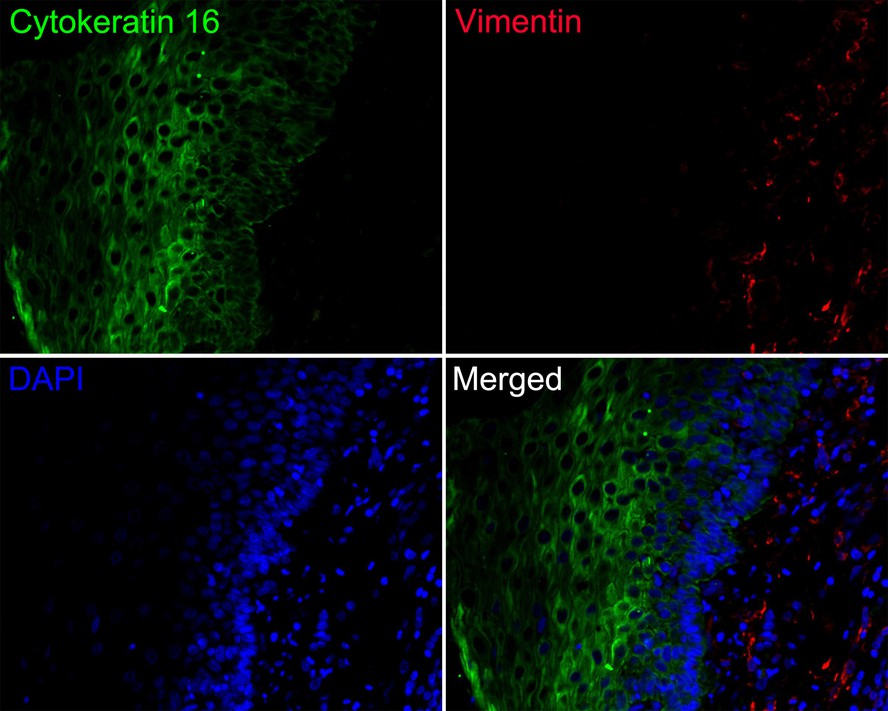
|
Fig1:
Immunofluorescence analysis of paraffin-embedded human esophagus tissue labeling Cytokeratin 16 (HA720137F) and Vimentin (EM0401). The section was pre-treated using heat mediated antigen retrieval with Tris-EDTA buffer (pH 9.0) for 20 minutes. The tissues were blocked in 10% negative goat serum for 1 hour at room temperature, washed with PBS. And then probed with the primary antibodies Cytokeratin 16 (HA720137F, green) at 1/50 dilution and Vimentin (EM0401, red) at 1/1,000 dilution overnight at 4 ℃, washed with PBS. iFluor™ 594 conjugate-Goat anti-Mouse IgG (HA1126) was used as the secondary antibody at 1/1,000 dilution. DAPI was used as nuclear counterstain. |
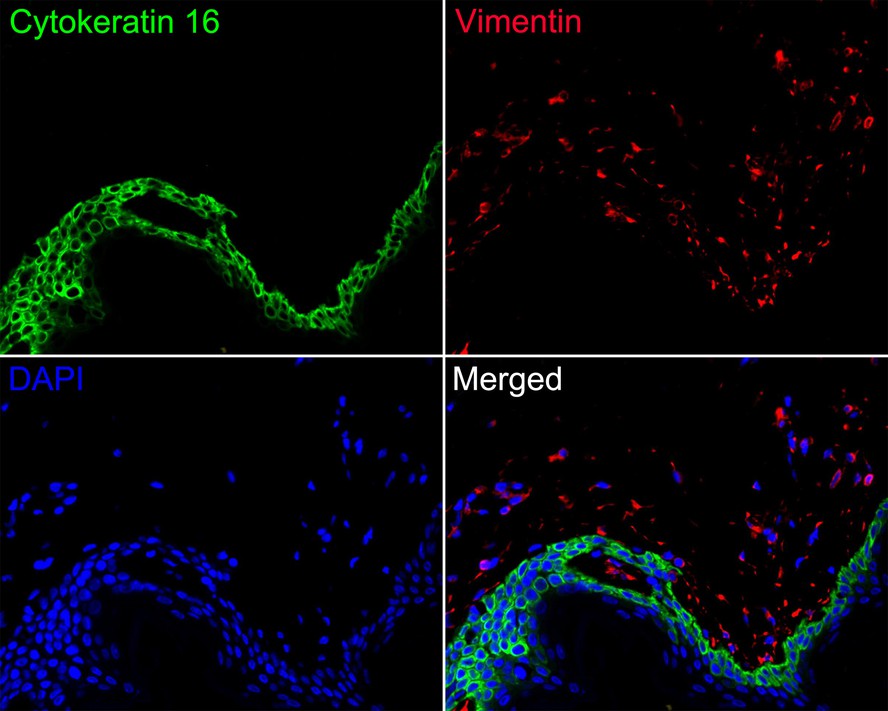
|
Fig2:
Immunofluorescence analysis of paraffin-embedded human skin tissue labeling Cytokeratin 16 (HA720137F) and Vimentin (EM0401). The section was pre-treated using heat mediated antigen retrieval with Tris-EDTA buffer (pH 9.0) for 20 minutes. The tissues were blocked in 10% negative goat serum for 1 hour at room temperature, washed with PBS. And then probed with the primary antibodies Cytokeratin 16 (HA720137F, green) at 1/200 dilution and Vimentin (EM0401, red) at 1/1,000 dilution overnight at 4 ℃, washed with PBS. iFluor™ 594 conjugate-Goat anti-Mouse IgG (HA1126) was used as the secondary antibody at 1/1,000 dilution. DAPI was used as nuclear counterstain. |
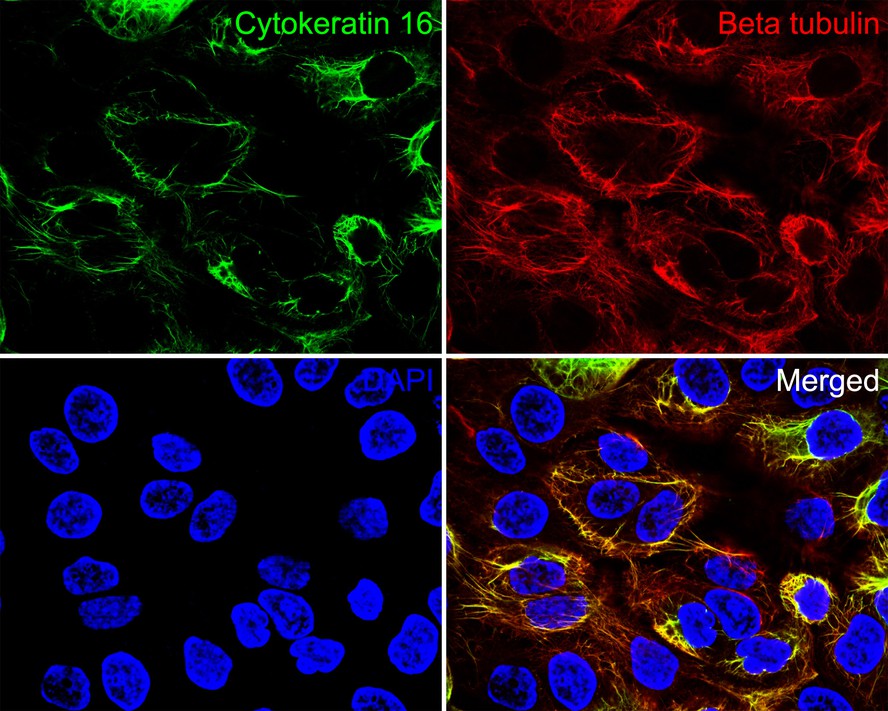
|
Fig3:
Immunocytochemistry analysis of HepG2 cells labeling Cytokeratin 16 with Rabbit anti-Cytokeratin 16 antibody (HA720137F) at 1/100 dilution. Cells were fixed in 100% methanol for 10 minutes, permeabilized with 0.1% Triton X-100 in PBS for 15 minutes, and then blocked with 1% BSA for 30 minutes at room temperature. Cells were then incubated with Rabbit anti-Cytokeratin 16 antibody (HA720137F) at 1/100 dilution in 1% BSA overnight at 4 ℃. Nuclear DNA was labelled in blue with DAPI. Beta tubulin (M1305-2, red) was stained at 1/200 dilution overnight at +4℃. Goat Anti-Mouse IgG H&L (iFluor™ 594, HA1126) were used as the secondary antibody at 1/800 dilution. |
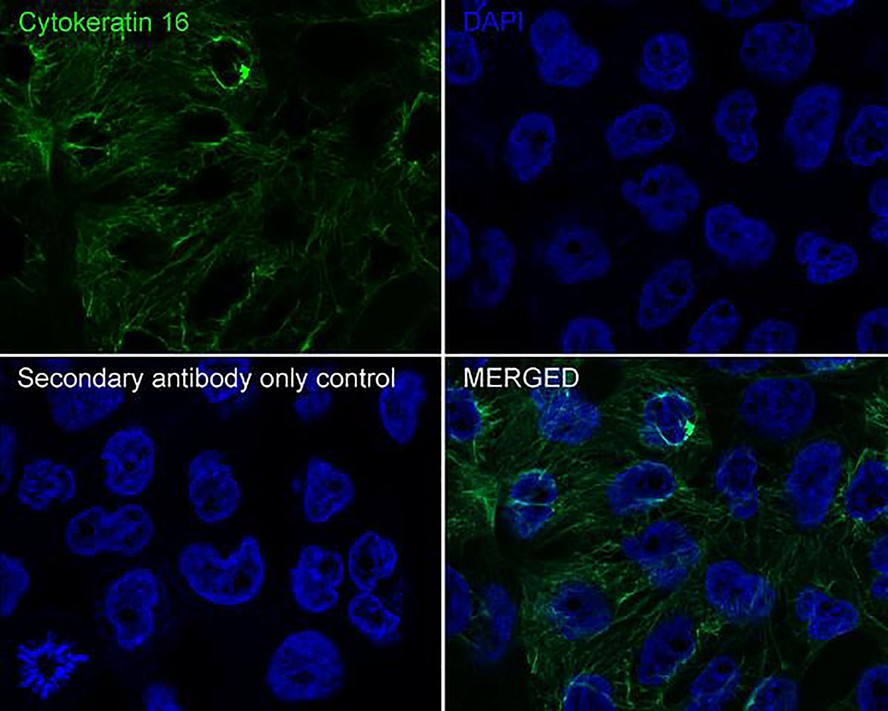
|
Fig4:
Immunocytochemistry analysis of A431 cells labeling Cytokeratin 16 with Rabbit anti-Cytokeratin 16 antibody (HA720137F) at 1/50 dilution. Cells were fixed in 100% methanol for 10 minutes, permeabilized with 0.1% Triton X-100 in PBS for 15 minutes, and then blocked with 1% BSA for 30 minutes at room temperature. Cells were then incubated with Rabbit anti-Cytokeratin 16 antibody (HA720137F) at 1/50 dilution in 1% BSA overnight at 4 ℃. Nuclear DNA was labelled in blue with DAPI. |
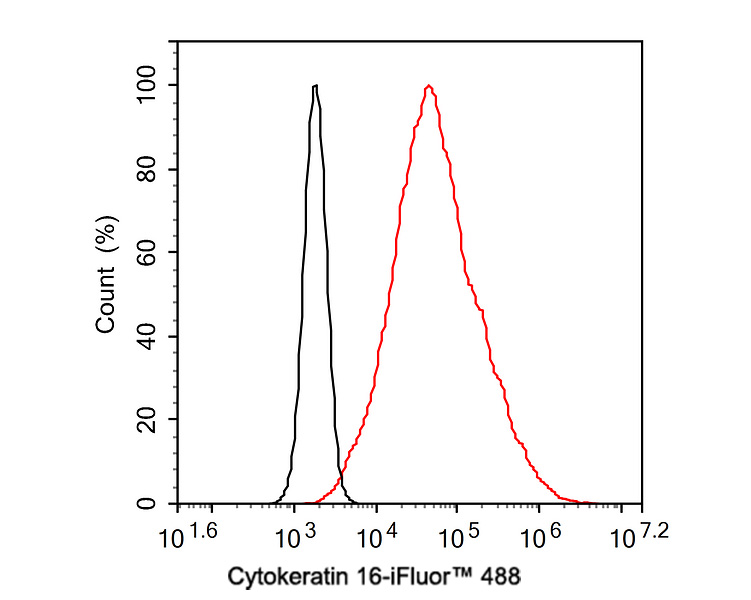
|
Fig5:
Flow cytometric analysis of A431 cells labeling Cytokeratin 16. Cells were fixed and permeabilized. Then incubated for 1 hour at +4℃ with Cytokeratin 16 (HA720137F, red, 1ug/ml). Unlabelled sample was used as a control (cells without incubation with primary antibody; black). |
Note: All products are “FOR RESEARCH USE ONLY AND ARE NOT INTENDED FOR DIAGNOSTIC OR THERAPEUTIC USE”.